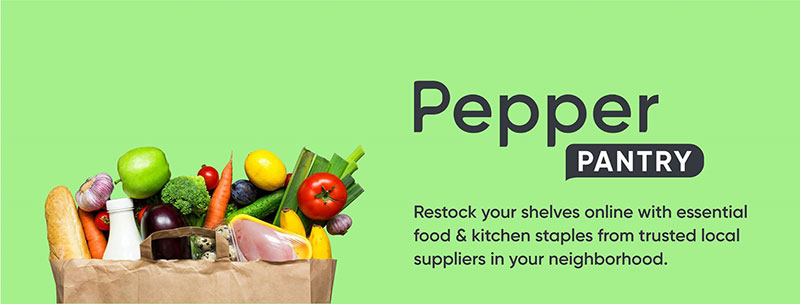As cracks emerge in the global food supply chain, an upstart called Pepper Pantry is giving at-home consumers the ability to order produce, meat, seafood and dry goods directly from smaller, family-run restaurant supply companies. Launched in New York City just before the COVID-19 pandemic and led by a small team with deep ties to Uber Eats, the new service is expanding quickly while spreading awareness that independent suppliers are hurting just like restaurants.
The promise of Pepper Pantry is certainly appealing during this time of zombie-apocalypse grocery shopping, sold out items and extended wait times for many delivery and curbside grocery services. Pepper seeks to give home cooks the ability to take delivery of high-quality meats straight from the farm, fresher produce and seafood that, in some cases, can be delivered just the day after it comes off the boat.
Pepper was co-founded by Bowie Cheung, previously the head of regional operations for Uber Eats in the U.S. and Canada. After leaving that position in 2019, Cheung moved from the Bay Area to New York City, and formally launched the company last October.
Originally launched asPepper for Restaurants to seamlessly connect restaurants with smaller, local suppliers in their network, the company abruptly changed its business model when the extent of the crisis for supplierscame to light in the early days of COVID-19.
“We came to understand that there was just a need for more modern tools for suppliers and restaurants to work together,” Cheung said. “So we came up with this idea to build the digital network that powers the food supply chain, which is a pretty abstract concept, but that terminology made so much sense given what we were seeing.”
Pepper for Restaurants first began service in January with a small group of restaurants in Manhattan. After quickly expanding service into New Jersey, Cheung said the business plan was “going really well, up until a couple of weeks ago” when the extent of the pandemic’s toll on the foodservice industry became clear and two-thirds of the company’s restaurant partners had either temporarily furloughed their staffs or closed their doors for good.
He added that being such a new company gave them the ability to “put together ideas, turn things around a pivot rather quickly.”
Cheung admitted it’s “really a difficult question” to determine whether Pepper’s shift to consumer delivery will be permanent, but underscored that farms and suppliers have an immediate need for new revenue streams.This dovetails well with consumers experiencing shortages, especially with several U.S. meatpacking facilities impacted by localized COVID-19 outbreaks.
While the current moment has primed the pump for such a direct-to-consumer offering, right-sizing the restaurant supply chain for individual consumers won’t be an easy undertaking.
To avoid a Sysco semi truck navigating suburban cul-de-sacs, Pepper’s shopping list of challenges will include right-sized delivery vehicles, schedules that work with home schedules and scaling down product quantities into smaller portions compared with the large shipments restaurants typically receive at the crack of dawn.
“The average consumer is not going to order cuts of ribeye $150 at a time or bacon $120 at a time,” Cheung said of the challenges. “Some folks will be able to supply in smaller quantities and some won’t.”
Another challenge, familiar to his team members with experience in the third-party delivery world, will be designing delivery routes and drop-offs that could maintain supplier profit margins with more, smaller deliveries compared to commercial operators.
First launched in the five boroughs of New York, Pepper Pantry has quickly expanded to much of New Jersey, Boston and parts of Pennsylvania, with additional locations planned to come online in the near future.
Consumers currently pay a flat $5 fee for the service, which Cheung said he hopes can be kept “as low as possible for as long as possible.” Suppliers are charged a marketing fee that’s a percentage of the overall basket size, and they are in charge of determining their own order minimums.
While Pepper has a Silicon Valley pedigree, the company’s model is familiar to Minnesota-based Schwan’s, which was founded in the 1950s and built a strong footing in the upper Midwest where its refrigerated trucks still troll through neighborhoods dropping off frozen foods, such as meat, pizzas, egg rolls and ice cream.
Schwan’s has since diversified into several subsets of the foodservice industry, but remains the largest direct-to-home delivery provider of frozen foods in the U.S., with a dozen manufacturing facilities across the country.
Cheung was unfamiliar with the brand, but said the parallels were “fascinating,” while highlighting that box trucks similar to those Schwan’s uses would likely be the medium of choice for suppliers venturing into the wild lands of American suburbia.
As he finds himself unexpectedly back in the direct-to-consumer delivery space, Cheung said he won’t forget “the things that we got right, but also the things that we got wrong” at Uber Eats.
“We didn’t lean in as much as we could have in terms of bringing the restaurant community along,” he said, and added that his team will continue to build and maintain close, personal relationships with restaurants and suppliers.
Going forward, he’s hoping Pepper finds traction as the global food system undergoes an unprecedented stress test that doesn’t appear to be easing any time soon.
“It’s clear that at this very moment there is a need for folks to be able to have food delivered to the home,” Cheung said. “Folks don’t necessarily want to go out and walk around the grocery store, with everything that’s going on, and it just happens to be the case that there’s a supply chain that’s custom built for that, which is incredibly under-utilized … so there’s a moment in time where it’s almost like these wholesales we are working with are built to service what’s happening right now.”




